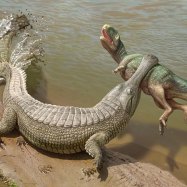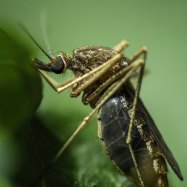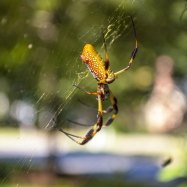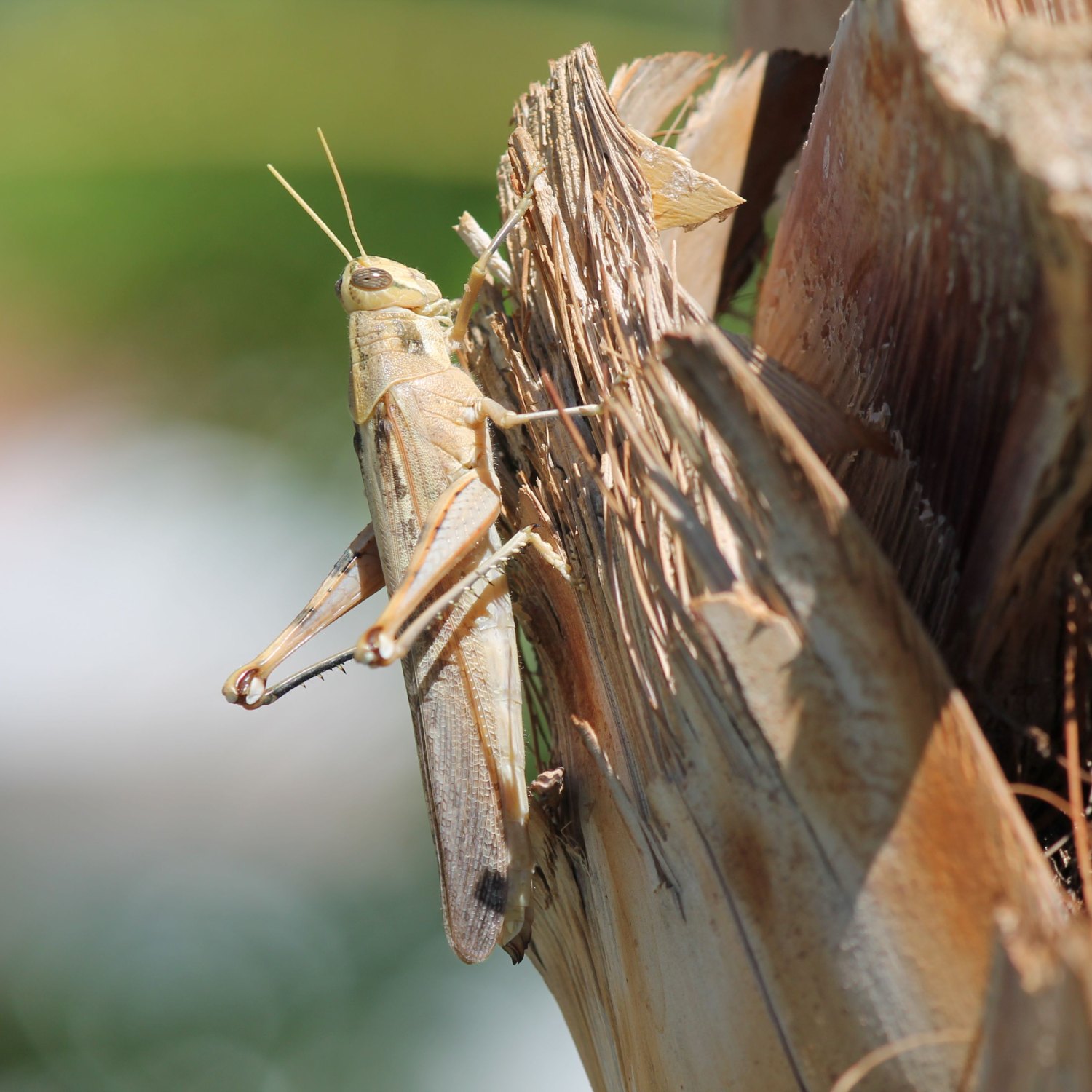
Desert Locust
Around 6 cm
The Desert Locust, also known as the grasshopper on steroids, can be found in deserts and semi-arid regions. With a body length of around 6 cm and a long body with long hind legs, they are skilled jumpers and can travel long distances. These insects belong to the family Acrididae and are known for their aggressive swarming behavior, causing destruction to crops and vegetation. Stay alert if you encounter them while exploring the desert! #Animals #DesertLocust #Nature
Animal Details Summary:
Common Name: Desert Locust
Kingdom: Animalia
Habitat: Deserts and semi-arid regions
The Mighty Desert Locust: Survival in the Harshest Conditions
There are many creatures in the animal kingdom that are known for their amazing adaptations and abilities. However, there is one insect that stands out from the rest when it comes to surviving in harsh and extreme conditions – the Desert Locust. With its ability to withstand the scorching heat and thrive in the desert environment, the Desert Locust truly is a remarkable creature. In this article, we will dive into the world of Desert Locusts and explore their unique features that make them the ultimate survivors Desert Locust.Scientifically known as Schistocerca gregaria, the Desert Locust is an orthopteran insect belonging to the family Acrididae. Its common name is derived from its habitat, as it is mainly found in deserts and semi-arid regions. Let's take a closer look at this intriguing creature and discover how it has adapted to its harsh surroundings.
Classification and Habitat
The Desert Locust belongs to the Kingdom Animalia, the largest and most diverse group of organisms on Earth. It is classified under the phylum Arthropoda, which includes jointed-legged animals such as insects, arachnids, and crustaceans. As an insect, the Desert Locust falls under the class Insecta, and its order is Orthoptera, which also includes grasshoppers and crickets.The Desert Locust's preferred habitat is in deserts and semi-arid regions. It can be found in Africa, the Middle East, and Southwest Asia. However, it is mainly found in North Africa, making it an essential part of the ecosystem in that region Diving Bell Spider. These insects are highly adaptable and can thrive in the harshest climates, where other living organisms struggle to survive. Their incredible ability to survive in such conditions has made them a topic of interest for researchers and scientists.
Physical Characteristics
The Desert Locust has a brown or green coloration, which enables it to blend in with its surroundings, providing an excellent camouflage against predators. Their body shape is long and slender, measuring around 6 cm in length. Their heads are small, and they have large compound eyes, which provide them with a keen sense of sight.One of the most striking features of the Desert Locust is its hind legs, which are exceptionally long and powerful. These legs enable them to jump incredible distances, making them swift and agile. In fact, the Desert Locust is known to be one of the fastest insects on the planet, with a record jump of over 12 inches!
Even though they are small in size, Desert Locusts are sturdy creatures that can withstand high temperatures and harsh winds. They have a hard exoskeleton, allowing them to retain water and stay hydrated for an extended period. This adaptation is crucial for their survival in the desert environment, where water is scarce.
Feeding Habits
Desert Locusts are best known for their voracious appetite. They are herbivores, feeding primarily on leaves, stems, flowers, and fruits of plants. These insects have a specialized mouthpart called mandibles, which they use to tear and chew vegetation. They can consume up to twice their body weight in food every day, making them a significant threat to crops and vegetation in the regions they inhabit.However, their feeding habits play a vital role in the ecosystem. They can regulate plant growth and prevent overgrazing in their habitat, promoting a healthy balance in the ecosystem. Without them, the desert environment may become overgrown, making it challenging for other living organisms to survive.
Reproduction and Migratory Behavior
Desert Locusts have a unique reproductive cycle, which is triggered by certain environmental conditions. When there is ample vegetation for them to feed on, and the weather is warm and humid, these insects can go through a process called gregarization. During this phase, Desert Locusts multiply rapidly, and their solitary behavior changes to that of a more social one.This gregarization phase is crucial to their survival, as it enables them to migrate in search of food and suitable breeding grounds. It is estimated that Desert Locusts can travel up to 150 km in a day, making it one of the most extensive insect migrations on Earth. This behavior allows them to avoid areas that have been overgrazed and find new sources of food and water.
Surviving with Sound
Apart from their physical adaptations, Desert Locusts have also developed a unique way of communicating with each other – through vibrational sounds. These insects produce sound by rubbing their hind legs against their wings, creating a low-frequency buzzing noise. This sound helps them to locate each other and gather in large groups, which is necessary for their survival and migration.These vibrational sounds also serve as a warning to other Desert Locusts of potential danger, allowing them to stay in sync and protect themselves. This communication method has been perfected by these insects over thousands of years, and it is an essential part of their survival strategy.
The Impact of Desert Locusts
Desert Locusts have a significant impact on the regions they inhabit, both positive and negative. While they may be viewed as pests due to their ability to cause significant damage to crops and vegetation, they also play a crucial role in maintaining a balanced ecosystem. By controlling plant growth and preventing overgrazing, Desert Locusts ensure that the desert environment remains healthy and habitable for other living organisms.However, when Desert Locusts reach plague proportions, they can have devastating effects on agriculture and local economies. They can destroy entire crops and cause food shortages, leading to hunger and poverty in affected regions. In recent years, there have been several outbreaks of Desert Locust swarms, causing severe damage and threatening food security in affected countries.
Efforts to Control Desert Locusts
Due to their potential for destruction, there have been many efforts to control Desert Locust populations. These include using pesticides, biological control methods such as fungi and bacteria, and environmental management techniques. While these methods may be effective in the short term, they have proven to be costly and unsustainable.In recent years, there has been a shift towards more sustainable and environmentally friendly methods of controlling Desert Locusts. These include using natural predators such as birds and wasps, and implementing practices that promote healthy ecosystems and prevent the gregarization of these insects.
Final Thoughts
The Desert Locust is undoubtedly a remarkable insect, with its ability to survive in the harshest conditions and adapt to challenging environments. Its role in the ecosystem cannot be underestimated, as it plays a vital part in maintaining balance in the desert environment.While there have been efforts to control its population, the Desert Locust continues to thrive and amaze us with its unique features and behavior. As we continue to learn more about these insects, we can gain a better understanding and appreciation for one of the most resilient creatures in the animal kingdom – the Desert Locust.

Desert Locust
Animal Details Desert Locust - Scientific Name: Schistocerca gregaria
- Category: Animals D
- Scientific Name: Schistocerca gregaria
- Common Name: Desert Locust
- Kingdom: Animalia
- Phylum: Arthropoda
- Class: Insecta
- Order: Orthoptera
- Family: Acrididae
- Habitat: Deserts and semi-arid regions
- Feeding Method: Herbivorous
- Geographical Distribution: Africa, the Middle East, and Southwest Asia
- Country of Origin: Found mainly in North Africa
- Location: Deserts and semi-arid regions
- Animal Coloration: Brown or green
- Body Shape: Long body with long hind legs
- Length: Around 6 cm
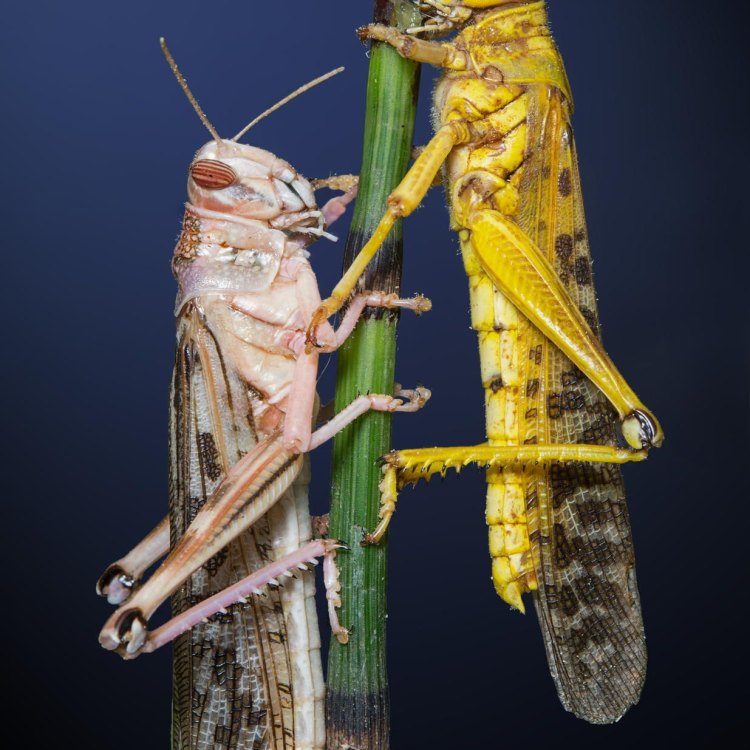
Desert Locust
- Adult Size: Around 6-7 cm
- Average Lifespan: About 3-5 months
- Reproduction: Sexual
- Reproductive Behavior: Males attract females with pheromones and courtship displays
- Sound or Call: Males produce buzzing or clicking sounds
- Migration Pattern: Highly migratory, forming large swarms
- Social Groups: Solitary when not swarming
- Behavior: Highly gregarious when swarming, forming massive swarms that can travel long distances
- Threats: Overpopulation, environmental conditions, and habitat degradation
- Conservation Status: Not listed as endangered
- Impact on Ecosystem: Can cause significant damage to crops and vegetation during outbreaks
- Human Use: Used as a source of food for humans and animals in some cultures
- Distinctive Features: Large size, distinctive coloration, long hind legs
- Interesting Facts: Desert locusts have the ability to change their behavior and morphology (phase) depending on environmental conditions
- Predator: Birds, reptiles, and other insect-eating animals
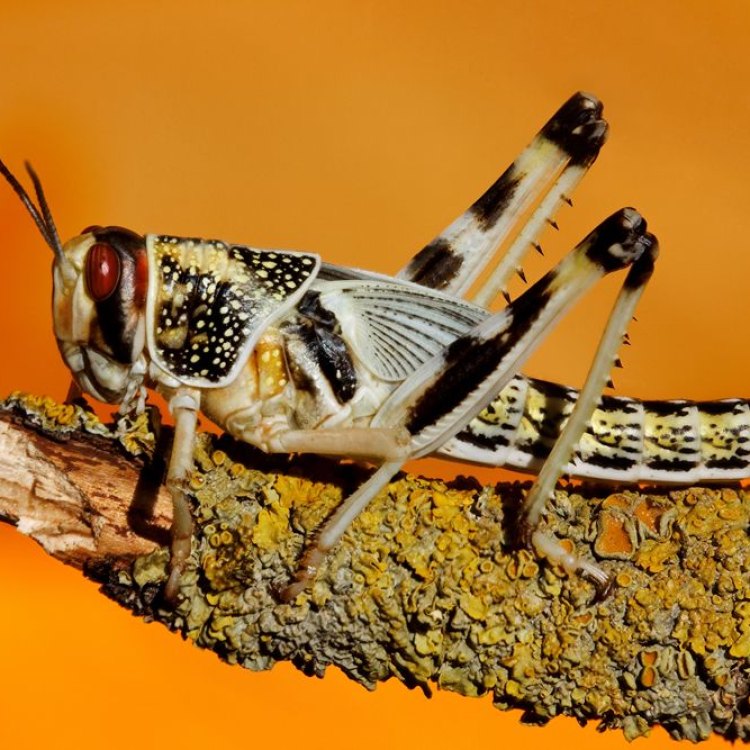
Schistocerca gregaria
The Incredible Desert Locust: An Amazingly Adaptable Insect
When one thinks of insects, images of small, scurrying creatures may come to mind. However, there is one insect that stands out among the rest for its size, behavior, and impact on the ecosystem - the desert locust.The desert locust, scientifically known as Schistocerca gregaria, is a type of short-horned grasshopper found in arid and semi-arid regions of Africa, the Middle East, and Asia. While it may look like an ordinary grasshopper at first glance, this remarkable insect has some unique and fascinating features that make it stand out PeaceOfAnimals.Com.
Let's start with its physical appearance. The average adult size of a desert locust is around 6-7 cm, making it one of the largest species of grasshoppers in the world. They have distinctive coloration, with a brownish-yellow body, dark spots on their abdomen, and red or orange hind wings. This coloration serves as camouflage, allowing them to blend in with their surroundings and avoid predators.
Speaking of predators, the desert locust has many natural enemies, including birds, reptiles, and other insect-eating animals. It is even used as a food source for humans and animals in some cultures, further highlighting its significance.
But what makes the desert locust truly remarkable is its ability to change its behavior and morphology (known as phases) depending on environmental conditions. This adaptation is crucial for its survival in the harsh desert environment where resources are limited. In fact, this is what makes the desert locust such a fascinating and adaptable insect Dwarf Gourami.
Now, let's dive deeper into the life of the desert locust and explore its behavior, threats, conservation status, and impact on the ecosystem.
Life and Reproduction
The average lifespan of a desert locust is around 3-5 months. This relatively short lifespan is due to the harsh living conditions in its habitat, where it experiences extreme temperatures and limited food resources. To survive and thrive in such an environment, the desert locust has developed unique reproductive behavior.Firstly, the desert locust reproduces sexually, with males attracting females through pheromones and courtship displays. This process begins when males start producing buzzing or clicking sounds to attract females. Once a male locust has caught the attention of a female, he will then perform a courtship display, which involves stridulating (rubbing its hind legs together) and clicking its wings.
After mating, females lay their eggs in the ground in clusters of around 60-70 eggs. These eggs can remain dormant for many months, waiting for the right conditions to hatch. They are also resistant to extreme temperatures, making it possible for the species to survive in deserts.
Behavior and Migration
Desert locusts are highly migratory insects, and their swarming behavior is what makes them stand out from other grasshoppers. When conditions are favorable, and food and water sources are abundant, these solitary insects gather together to form massive swarms.The transformation from a solitary to a gregarious (social) phase is triggered by a combination of environmental conditions, primarily an increase in food availability and moisture. When a swarm forms, it can consist of millions of locusts, covering an area of up to 120 square kilometers. These massive swarms are a sight to behold, and their impact can be both awe-inspiring and devastating.
When in their gregarious phase, these insects can travel long distances, flying at an average speed of 15 km per hour. They are highly adaptive, capable of adjusting their flying altitude to avoid harsh weather conditions. Incredibly, they can also change direction if they encounter an obstacle, such as a mountain range, on their migratory path.
The formation of swarms not only allows for better protection from predators but also provides better access to food sources. However, this behavior can also have destructive consequences and is a significant threat to agriculture and the livelihoods of people in affected regions.
Threats and Conservation Status
One of the significant threats to desert locust populations is overpopulation. When environmental conditions are favorable, and food and water sources are plentiful, locusts can reproduce rapidly, causing a significant increase in their population. This can result in depletion of food sources and overcrowding, leading to a "competition phase." During this phase, the locusts become more aggressive, and their behavior changes, leading to damage to crops and vegetation.Environmental conditions also play a crucial role in the formation and behavior of swarms. Droughts, followed by periods of rainfall, have been linked to the formation of locust swarms. This pattern is also exacerbated by climate change, making it a significant threat to the survival of the species.
Habitat degradation is another significant threat to the desert locust. As the demand for agricultural land and urbanization increases, their natural habitat is shrinking. This limits the locusts' access to food and water sources, forcing them to migrate in search of suitable habitats. This, in turn, increases the risk of conflict with humans and further exacerbates the effects of their swarming behavior.
Despite these threats, the desert locust is not listed as endangered. Thanks to its adaptability and ability to bounce back from unfavorable conditions, the species has been able to maintain stable populations. However, with the increasing effects of climate change and human activities, it is crucial to monitor and manage locust populations to prevent outbreaks and minimize the impact on agriculture and livelihoods.
Impact on the Ecosystem
The desert locust's behavior and migratory patterns can have a significant impact on the ecosystem. During outbreaks, when populations are high, locusts can cause significant damage to crops and vegetation, leading to food shortages and economic losses for farmers and communities.However, in their solitary phase, desert locusts play an essential role in the ecosystem as herbivores. They consume dead plant matter, acting as nature's clean-up crew, and aid in nutrient recycling. They also provide a food source for predators, maintaining the balance of the ecosystem.
Furthermore, the migratory behavior of the desert locust can also have positive impacts on the environment. Their droppings act as natural fertilizers, enriching the soil and promoting plant growth. This is especially important in the arid and semi-arid regions where they are found, where nutrients are scarce.
Human Use and Interesting Facts
The desert locust has been an important source of food for humans and animals in some cultures for centuries. In some parts of the world, fried or roasted locusts are considered a delicacy and are a significant source of protein.But perhaps the most fascinating aspect of the desert locust is its ability to change its behavior and morphology depending on environmental conditions. This phenomenon, known as phenotypic plasticity, allows the species to adapt and thrive in harsh conditions. It also helps explain their survival as a species for thousands of years.
The desert locust is a marvel of evolution, an insect that has perfected the art of adaptation to survive in one of the harshest environments on Earth.
The Amazing Adaptability of the Desert Locust
In conclusion, the desert locust is an incredible and unique insect that continues to fascinate scientists and researchers alike. From its size and coloration to its behavior and migratory patterns, every aspect of this insect is shaped by its adaptability to survive in the harsh desert environment.While they may pose a threat to agriculture and livelihoods, it is essential to understand and appreciate the role of the desert locust in the ecosystem. With proper monitoring and management, we can coexist with this remarkable insect and ensure its survival for generations to come. The desert locust truly is an amazingly adaptable creature, and its story is a testament to the resilience and diversity of this planet's species.
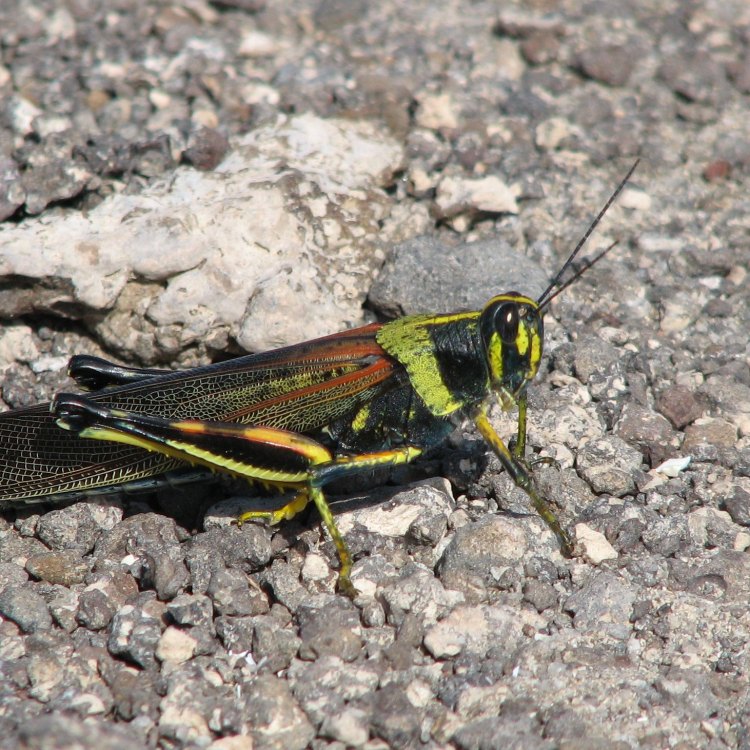
The Mighty Desert Locust: Survival in the Harshest Conditions
Disclaimer: The content provided is for informational purposes only. We cannot guarantee the accuracy of the information on this page 100%. All information provided here may change without prior notice.







